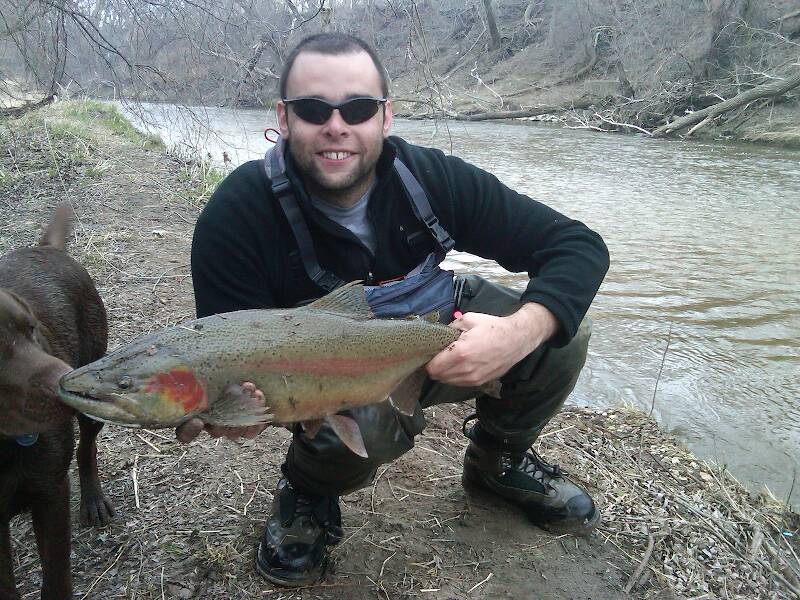
Salmonflies
Pteronarcys californica
The giant Salmonflies of the Western mountains are legendary for their proclivity to elicit consistent dry-fly action and ferocious strikes.
Featured on the forum

This species was fairly abundant in a February sample of the upper Yakima.

Troutnut is a project started in 2003 by salmonid ecologist Jason "Troutnut" Neuswanger to help anglers and
fly tyers unabashedly embrace the entomological side of the sport. Learn more about Troutnut or
support the project for an enhanced experience here.
GoofusBug
Posts: 31
Posts: 31
GoofusBug on Jul 9, 2009July 9th, 2009, 3:28 pm EDT
Hey can I use chapstick for dubbing wax or do you think the camphor in it would bug the fish?
Softhackle on Jul 10, 2009July 10th, 2009, 2:05 am EDT
Hi,
I wouldn't take the chance. Tying wax isn't very expensive, and there are ways to make your own. Sometimes, for touch dubbing I just use a little water.
Make your own.
Make sure you check out the link on this page for using a wax toilet seal ring if you like your wax sticky.
Mark
I wouldn't take the chance. Tying wax isn't very expensive, and there are ways to make your own. Sometimes, for touch dubbing I just use a little water.
Make your own.
Make sure you check out the link on this page for using a wax toilet seal ring if you like your wax sticky.
Mark
"I have the highest respect for the skilled wet-fly fisherman, as he has mastered an art of very great difficulty." Edward R. Hewitt
Flymphs, Soft-hackles and Spiders: http://www.troutnut.com/libstudio/FS&S/index.html
Flymphs, Soft-hackles and Spiders: http://www.troutnut.com/libstudio/FS&S/index.html
JAD on Jul 10, 2009July 10th, 2009, 6:22 am EDT
If your not trying to make the thread a certain color, I like to use a glue stick that the kids use at school.
jAD
jAD
They fasten red (crimson red) wool around a hook, and fix onto the wool two feathers which grow under a cock’s wattles, and which in colour are like wax.
Radcliffe's Fishing from the Earliest Times,
Shawnny3 on Jul 11, 2009July 11th, 2009, 5:08 am EDT
I have more kinds of wax than the average tier, and the vast majority of the time they are all more trouble than they're worth. When I'm dubbing a fly, I never use wax anymore (except what's on the pre-waxed thread). I've found that most problems with dubbing can be fixed by using the correct (which is to say, small) amount of dubbing at a time and making sure always to turn it onto the thread in the same direction. Make sure you get the dubbing evenly distributed around the thread by twisting loosely at first, only using a lot of pressure once the dubbing is adequately surrounding the thread - otherwise you get a noodle of dubbing that is not well attached to the thread. Good dubbing technique renders wax needless.
-Shawn
-Shawn
Jewelry-Quality Artistic Salmon Flies, by Shawn Davis
www.davisflydesigns.com
www.davisflydesigns.com
JAD on Jul 11, 2009July 11th, 2009, 2:22 pm EDT
Hi guys
Shawn I don't agree, their are techniques that require wax or glue. If a person is trying to touch dub as for the LaFontaine sparkle pupa or some of the older soft hackles it a good idea to use something sticky. Wax will also turn silk thread a different hue by using a darker color wax, some times they add soot to the wax to make it a certain color.
No Disrespect intended
Regards
jAD
Shawn I don't agree, their are techniques that require wax or glue. If a person is trying to touch dub as for the LaFontaine sparkle pupa or some of the older soft hackles it a good idea to use something sticky. Wax will also turn silk thread a different hue by using a darker color wax, some times they add soot to the wax to make it a certain color.
No Disrespect intended
Regards
jAD
They fasten red (crimson red) wool around a hook, and fix onto the wool two feathers which grow under a cock’s wattles, and which in colour are like wax.
Radcliffe's Fishing from the Earliest Times,
Shawnny3 on Jul 11, 2009July 11th, 2009, 4:44 pm EDT
Certainly none taken, John - each person uses different techniques and has different preferences. The point about silk thread is an important qualification because it typically comes unwaxed, and I usually use wax with it (though not always). Because silk is often called for in soft-hackle dressings, the point is especially valid. As for other delicate dressings, wax can certainly help, but I still avoid it because I hate having goopy stuff on my hands while I'm tying, and when I do use it I try to use the least sticky wax I can get away with.
Some great tiers swear by the stickiest wax possible and other great tiers eschew wax completely, with the whole spectrum in between well represented. Use of wax has long been one of the most disagreed upon aspects of flytying, and each tier must find his own preferences. Certainly, please do not take my preferences as any more than that, just what works for me.
-Shawn
Some great tiers swear by the stickiest wax possible and other great tiers eschew wax completely, with the whole spectrum in between well represented. Use of wax has long been one of the most disagreed upon aspects of flytying, and each tier must find his own preferences. Certainly, please do not take my preferences as any more than that, just what works for me.
-Shawn
Jewelry-Quality Artistic Salmon Flies, by Shawn Davis
www.davisflydesigns.com
www.davisflydesigns.com
Softhackle on Jul 12, 2009July 12th, 2009, 4:11 am EDT
Hi,
For waxing silk with a less sticky approach, I like just a small bit of plain beeswax to hold the silk in place on the hook when wrapping. For silk thread used for soft-hackle bodies, I use no wax. I want the silk to take up water and become translucent. To me this is the beauty of the silk used in soft-hackle bodies. This is true of silk floss bodies as well. I don't wrap tying thread under the floss, just tie it on, wrap down and back and tie off. I think this is very important when using real silk for these flies.
Mark
For waxing silk with a less sticky approach, I like just a small bit of plain beeswax to hold the silk in place on the hook when wrapping. For silk thread used for soft-hackle bodies, I use no wax. I want the silk to take up water and become translucent. To me this is the beauty of the silk used in soft-hackle bodies. This is true of silk floss bodies as well. I don't wrap tying thread under the floss, just tie it on, wrap down and back and tie off. I think this is very important when using real silk for these flies.
Mark
"I have the highest respect for the skilled wet-fly fisherman, as he has mastered an art of very great difficulty." Edward R. Hewitt
Flymphs, Soft-hackles and Spiders: http://www.troutnut.com/libstudio/FS&S/index.html
Flymphs, Soft-hackles and Spiders: http://www.troutnut.com/libstudio/FS&S/index.html
CaseyP on Jul 12, 2009July 12th, 2009, 4:44 am EDT
the chapstick idea is going into my "absolute minimum" kit. that is the kit that can live at the bottom of the laundry basket that holds all my fishing gear in the car, in case the trees eat all of a necessary fly, or some hatch comes up. dubbing stuffed into a cut off soda straw was the other really neat idea, right up there with those cheap kits in little wood boxes that have a vise and some tools. there is even thread that is a sort of translucent olive and can tie any color. you would never want to tie more than half a dozen with this rig, but it can sure give you more confidence on the stream!
"You can observe a lot by watching." Yogi Berra
Geezer on Jul 24, 2009July 24th, 2009, 4:44 am EDT
I don't know if Chapstick would have the same tackiness as actual dubbing wax, but it still might work. The camphor and other ingredients may be a problem, though.
The only time I put wax onto the thread anymore is when doing a dubbing loop, otherwise I just touch my forefinger to the stick and rub it with my thumb for a few seconds. You learn after a while just how much dubbing you need on your finger for the type of dubbing you are using. (Some synthetics need more.)
I find that this technique lets me apply most dubbings quite nicely.
The only time I put wax onto the thread anymore is when doing a dubbing loop, otherwise I just touch my forefinger to the stick and rub it with my thumb for a few seconds. You learn after a while just how much dubbing you need on your finger for the type of dubbing you are using. (Some synthetics need more.)
I find that this technique lets me apply most dubbings quite nicely.
CaseyP on Jul 24, 2009July 24th, 2009, 7:58 am EDT
at a tying workshop last winter, one of the other participants mentioned that he uses Payette Flotant as a dubbing wax, and his flies float like corks. i gave it a try and have decided that it's great for dries, since the stuff gets all over my fingers and so it corrals the stray fibers. i'll let you know pretty soon if it made everything float better. for nymphs i'll stick to the regular stuff with the hair and fibers stuck all over the top. where does it all come from?
"You can observe a lot by watching." Yogi Berra
Lastchance on Jul 26, 2009July 26th, 2009, 11:47 am EDT
One thing we haven't discussed is dry skin--another reason to use wax. My hands get so dry that the dubbing and thread stick to my fingers. The only way I can dub properly is by using a touch of wax. In addition, whip finishing by hand becomes impossible. Just yesterday I had to use a whip finishing tool because the thread was sticking to my fingers and I was breaking it off. I also use a pumice stone to smooth my fingers. For some of us dubbing wax is necessary.
Francesco on Sep 23, 2009September 23rd, 2009, 3:23 pm EDT
Try the "glue" out of "sticky" muose trap!
francesco
Gilbert on Dec 25, 2009December 25th, 2009, 6:24 am EST
The person that was asking about using chap stick. I have used it, but I have taken all of the chap stick material from the tube and replaced it with my own sticky wax. I cut a slot in the top of the tube where the cap fits and I can put my finger over the top of the wax and press down lightly as I pull the thread through the wax. It is not messy and when you are finished just replace the cap and you can keep it clean . You dont have to fill the whole tube as a little goes a long way.
Gutcutter on Dec 28, 2009December 28th, 2009, 3:31 am EST
i use wax only on my dominant index finger and thumb when i'm creating a very tight string of dubbing such as small emerger abdomen. when using natural/synthetic blends i tend to dub directly onto the thread. i feel it gives the pattern a more natural appearance. i don't use pure natural dubbing very much anymore. my $.02 worth
All men who fish may in turn be divided into two parts: those who fish for trout and those who don't. Trout fishermen are a race apart: they are a dedicated crew- indolent, improvident, and quietly mad.
-Robert Traver, Trout Madness
-Robert Traver, Trout Madness
Flyflinger on Feb 16, 2015February 16th, 2015, 6:29 am EST
Except for touch-dubbing, I hardly ever used dubbing wax after a few years of tying, though I had accumulated three or four Overton's Wonder Wax before it disappeared. I usually wet my thumb and forefinger and applied a thin noodle or, if necessary, used a dubbing loop. Then recently, I discovered North Country soft hackle flies and after some research my impression of wax changed. It seems necessary for silk thread to strengthen the thread, retain the color when the silk is wet, or change the color somewhat. For example, the Waterhen Bloa uses Pearsall's Gossamer silk in a primrose color. But the thread is heavily wax with a dark cobbler's wax to bring out a yellow-olive color. The original recipe for Stewart's Black Spider uses a dark brown silk thread, which is heavily wax with cobbler's wax. I like the way wax keeps silk wraps from drifting and one doesn't need to spoil the head of a fly with adhesive or varnish. A whip-finish with waxed silk won't loosen.
Gutcutter on Feb 16, 2015February 16th, 2015, 1:13 pm EST
i don't use pure natural dubbing very much anymore.
Funny.
5 years later, I use almost no synthetic dubbing.
All men who fish may in turn be divided into two parts: those who fish for trout and those who don't. Trout fishermen are a race apart: they are a dedicated crew- indolent, improvident, and quietly mad.
-Robert Traver, Trout Madness
-Robert Traver, Trout Madness
Kschaefer3 on Feb 17, 2015February 17th, 2015, 7:36 am EST
i don't use pure natural dubbing very much anymore.
Funny.
5 years later, I use almost no synthetic dubbing.
Why do you think you made that switch?
Quick Reply
Related Discussions
Topic
Replies
Last Reply
18
Feb 19, 2016
by TNEAL
by TNEAL







